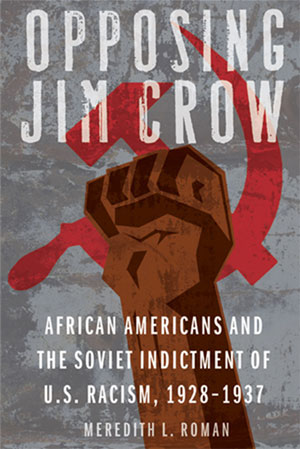
Not so long ago in our nation’s history Jim Crow was the law of the land, especially in the South. As a system of federal, state and local laws designed to enforce segregation, Jim Crow was the main embodiment of U.S. institutional racism for nearly a century – from the defeat of post-Civil War Reconstruction until the mid-1960s with the victories of the civil rights movement.
Meredith L. Roman’s Opposing Jim Crow: African Americans and the Soviet Indictment of U.S. Racism, 1928-1937 critically investigates what she calls “Soviet antiracism,” as a “field in which [antiracist] themes, images, and manifestations were glorified, redefined, and contested by various individuals and organizations” with a common objective: to represent the Soviet Union “as a society where racism was absent.”
The book is a nuanced analysis of a specific time in Soviet history, as well as a specific ideological projection. Opposing Jim Crow looks at Soviet antiracism, which “juxtapose[ed] blacks’ inclusion in the Soviet body politic with their exclusion from U.S. society,” as a “morally superior antithesis” to American Jim Crow racism.
Roman focuses her study on the years 1928 through 1937, as the interwar, post-World War I and pre-Wold War II, decade. While the Soviet government and its leaders never gave up on the struggle for full equality for African Americans – or the projection of Soviet antiracism – Roman argues that priorities shifted due to changes in the national and international political landscape. For example, pre-1928 was a period of internal civil war and the eventual consolidation of power, while post-1937 was a period where anti-fascism became the focus due to the growing Nazi war machine.
Chapter 1 focuses on Robert Robinson, an African American employed by the Stalingrad Tractor Factory who was attacked by two white workers, the trial and expulsion from the Soviet Union of the white workers, and the response of Soviet authorities, trade unions and press to the attack.
As a result of the attack Soviet authorities “launched a campaign to institute international [anti-capitalist, antiracist] education among foreign laborers in factories around the country,” and ultimately deported “seventeen additional American workers who they deemed the most ‘fascist’ and ‘reactionary.'” Additionally, trade union committees across the Soviet Union passed resolutions expressing their indignation about racism, wrote letters of support to Robinson, and rallied to recommit themselves to antiracism.
At times, Roman paints the Soviet response to Robinson’s attack as cynical and self-serving. She writes that, although Soviet authorities turned Robinson into a “heroic black worker,” they also “omitted” personal information, “nearly eliminate[ing] Robinson as an individual.” Furthermore, the press “never provided [readers] with the complete description of the altercation,” as it did not fit into the narrative of Robinson as “a victim of racial injustice … who needed Soviet workers to defend him.”
In short, while Roman highlights the very real distinctions between institutional Soviet antiracism and institutional U.S. racism, she also argues that Soviet antiracism was paternalistic at times, presenting Robinson as a figure that “symbolized all black workers, whose rights the Soviet Union defended.” However, Robinson himself saw Soviet antiracism as sincerely “intolerant of racial animosity,” and he also contrasted Soviet antiracism to American racism and “refused to acquiesce to the designs of the American racists.”
Roman’s Opposing Jim Crow also has chapters on “Representations of American Racial Apartheid and Soviet Racelessness,” “The Scottsboro Campaign,” and “African American Architects of Soviet Antiracism,” which included African American Communist leaders like Harry Haywood and James Ford. However, the last chapter is probably the most interesting – at least for me. It focuses on “The Promises of Soviet Antiracism and the Integration of Moscow’s International Lenin School.”
Roman writes that in September 1931, 12 African Americans began what would become “a different sort of antiracist experiment” by enrolling in the International Lenin School and “embarking on a unique experiment in American racial integration on Soviet soil.”
Many historians have documented the Communist Party USA’s vanguard role as a model of racial integration that organized interracial social events, registered African Americans to vote, and fought the then lilly-white trade union policies of the AFL, among many other examples. According to Roman, “the white and black Americans enrolled in the Lenin School in the fall of 1931 faced a far greater challenge; they were required to coexist as equals in classrooms, dormitories, and cafeterias for an entire year.”
Roman writes that while some “white American [communist] colleagues committed racist offenses” at the Lenin School, African American communists “consistently invoked Soviet antiracism” and demanded “the freedom from racism it promised them.” “In the process,” Roman continues, they helped define “what antiracism and freedom from racism looked like,” thereby shaping the Soviet Union’s and the Communist International’s perspective on racism. That is completely at odds with the idea in mainstream, Cold War, anticommunist historiography that the CPUSA was nothing more than an appendage of the Soviet Union and the Comintern.
Opposing Jim Crow is an interesting read. It highlights a unique, if largely ignored, aspect of Soviet history. While Roman’s analysis at times belittles and dismisses the Soviet commitment to antiracism as mere propaganda in a larger world of international power politics, Opposing Jim Crow sheds light on the very real impact of institutionalized Soviet antiracism, which makes this book a welcome addition to the history of the Soviet Union.
Book information:
“Opposing Jim Crow: African Americans and the Soviet Indictment of U.S. Racism, 1928-1937”
By Meredith L. Roman
2012, University of Nebraska Press, 301 pages
Photo: University of Nebraska Press












Comments